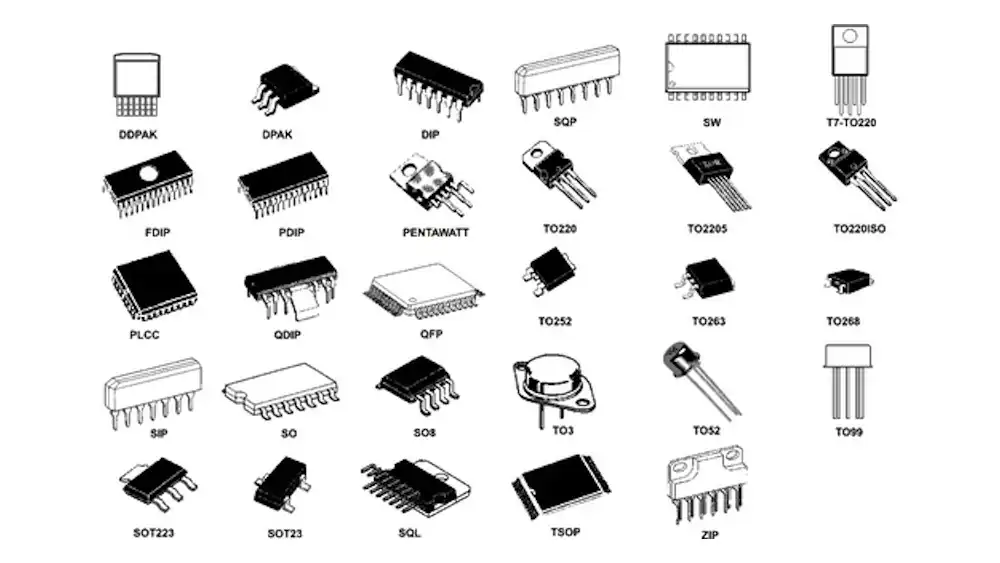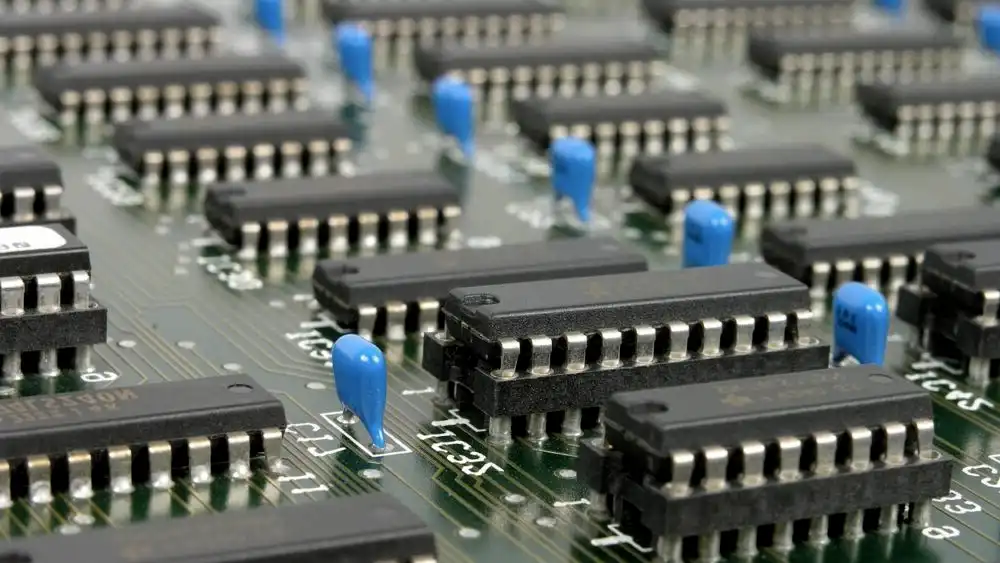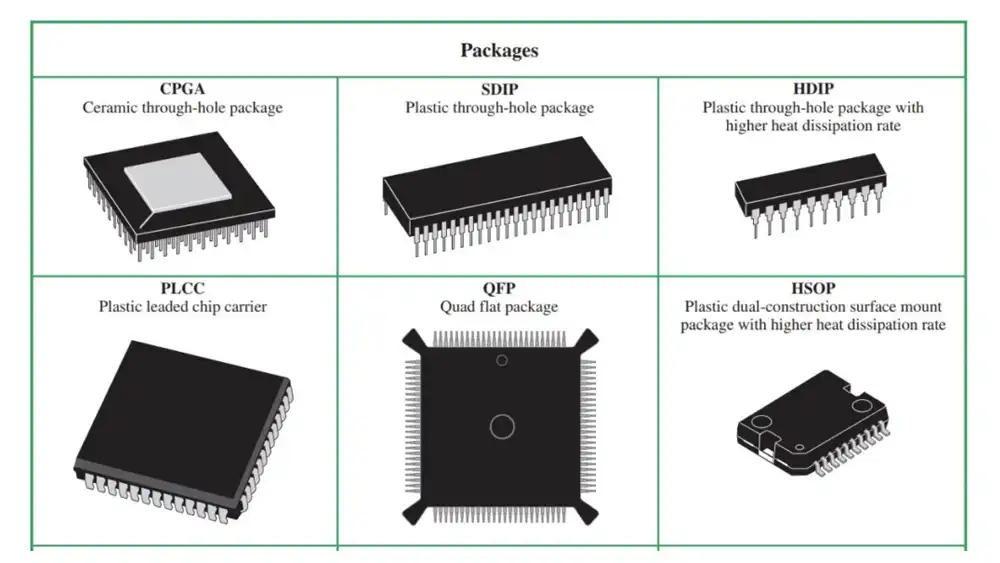Integrated circuits, often referred to as ICs or microchips, are the backbone of modern electronics. These tiny wonders of technology have revolutionized the way we live, work, and communicate.
In this comprehensive guide, we will explore the various types of integrated circuits, their applications, and the impact they have on our daily lives.
Types of Integrated Circuit

Integrated circuits (ICs) encompass a diverse array of electronic components, each tailored for specific functions and applications. Understanding the various types of integrated circuits is crucial for grasping their significance in modern technology.
Here’s a closer look at the main types of integrated circuits, and here is a list of integrated circuit packaging types in the following:
Analog Integrated Circuits (ICs): Analog ICs are designed to process continuous signals, making them indispensable in applications where precision and accuracy are paramount. They play pivotal roles in audio amplifiers, voltage regulators, analog-to-digital converters, and signal processing circuits.
Digital Integrated Circuits (ICs): Digital ICs operate using discrete values of voltage to represent binary numbers, making them fundamental components in digital electronics. From simple logic gates to complex microprocessors, digital ICs form the backbone of modern computing and communication systems.
Mixed-Signal Integrated Circuits (ICs): Combining elements of both analog and digital circuits, mixed-signal ICs bridge the gap between the analog and digital domains. They are widely used in data conversion, telecommunications, sensor interfaces, and control systems, where seamless integration of analog and digital functionalities is required.
Memory Integrated Circuits (ICs): Memory ICs are dedicated to storing data and program instructions for electronic devices. They come in various forms, including Read-Only Memory (ROM), Random Access Memory (RAM), and flash memory, catering to diverse memory storage needs across different applications.
Microprocessor Integrated Circuits (ICs): Microprocessors serve as the computational engines in computers, smartphones, and countless other electronic devices. These highly versatile ICs execute instructions, perform arithmetic and logic operations, and coordinate the overall functionality of electronic systems.
Microcontroller Integrated Circuits (ICs): Microcontrollers pack a CPU, memory, and peripheral interfaces into a single chip, making them ideal for embedded systems and Internet of Things (IoT) applications. They are extensively used in consumer electronics, industrial automation, automotive systems, and smart home devices.
Application-Specific Integrated Circuits (ASICs): ASICs are custom-designed ICs tailored for specific applications, offering optimized performance, power efficiency, and cost-effectiveness compared to general-purpose ICs. They find applications in diverse fields such as telecommunications, automotive electronics, and medical devices.
Field-Programmable Gate Arrays (FPGAs): FPGAs are reconfigurable ICs that can be customized to implement various digital circuits and algorithms. They are invaluable tools for prototyping, rapid development, and deployment of complex digital systems in fields like telecommunications, aerospace, and high-performance computing.
These distinct types of integrated circuits showcase the versatility and innovation driving advancements in electronics. Whether it’s enabling seamless communication, powering computational tasks, or storing vast amounts of data, integrated circuits continue to shape the technological landscape in profound ways.
How Are Integrated Circuits Categorized

Integrated circuits (ICs) are categorized based on various factors, including their functionality, design complexity, and intended applications. Understanding the classification types of integrated circuits is essential for effectively utilizing integrated circuits in electronic systems. Here’s an overview of how integrated circuits are categorized:
Functionality:
Integrated circuits are primarily categorized based on their functionality, which refers to the specific tasks they perform within electronic devices. The main functional categories include:
- Analog Integrated Circuits (ICs): These circuits process continuous signals and are essential for tasks such as amplification, filtering, and signal conditioning.
- Digital Integrated Circuits (ICs): Digital ICs operate using discrete values of voltage to represent binary numbers, facilitating tasks such as logic operations, data processing, and memory storage.
- Mixed-Signal Integrated Circuits (ICs): Mixed-signal ICs integrate both analog and digital circuitry on a single chip, enabling seamless interaction between analog and digital signals in applications such as data conversion and sensor interfacing.
- Memory Integrated Circuits (ICs): Memory ICs store data and program instructions for electronic devices, including Read-Only Memory (ROM), Random Access Memory (RAM), and flash memory.
- Microprocessor Integrated Circuits (ICs): Microprocessors are complex ICs that serve as the central processing units in computers and other digital systems, executing instructions and coordinating system operations.
- Microcontroller Integrated Circuits (ICs): Microcontrollers combine a microprocessor core with memory and peripheral interfaces, making them ideal for embedded systems and IoT applications.
- Application-Specific Integrated Circuits (ASICs): ASICs are custom-designed ICs tailored for specific applications, offering optimized performance and functionality for specialized tasks.
- Field-Programmable Gate Arrays (FPGAs): FPGAs are reconfigurable ICs that can be programmed to implement custom digital circuits, providing flexibility and adaptability in system design.
Design Complexity:
Integrated circuits are also categorized based on their design complexity, which refers to the level of integration and sophistication of circuit elements on a chip. This categorization includes:
- Simple Integrated Circuits: These ICs contain basic circuit elements such as transistors, resistors, and capacitors, and are typically used for simple logic functions or analog signal processing.
- Complex Integrated Circuits: Complex ICs integrate a larger number of circuit elements and functionalities, enabling more advanced operations such as microprocessor control, memory storage, and digital signal processing.
- System-on-Chip (SoC): SoC ICs integrate entire electronic systems onto a single chip, including microprocessors, memory, input/output interfaces, and peripheral controllers, offering complete solutions for specific applications.
Application Domain:
Integrated circuits can also be categorized based on their intended application domains, such as consumer electronics, automotive systems, industrial automation, telecommunications, and medical devices.
By understanding these categories, engineers and designers can select the most appropriate integrated circuits for their specific application requirements, ensuring optimal performance and functionality in electronic systems.
Types of Integrated Circuit Packages

Integrated circuits (ICs) are packaged in various forms to protect the delicate semiconductor components and facilitate their integration into electronic systems. The package type of an IC plays a crucial role in determining its physical dimensions, thermal properties, and electrical connections. Here are some common types of integrated circuit packages:
Dual In-Line Package (DIP):
- The DIP is one of the oldest and most traditional IC package types.
- It features two parallel rows of pins extending from the sides of the package.
- DIP packages are typically used for through-hole mounting on circuit boards.
Small Outline Integrated Circuit (SOIC):
- SOIC packages are smaller and more compact than DIP packages.
- They feature surface-mount leads that extend from the sides of the package.
- SOIC packages are widely used in modern electronic devices due to their space-saving design.
Quad Flat Package (QFP):
- QFP packages have leads extending from all four sides of the package.
- They offer higher lead counts and increased pin density compared to DIP and SOIC packages.
- QFP packages are commonly used in applications requiring high pin count and compact size, such as microcontrollers and memory ICs.
Ball Grid Array (BGA):
- BGA packages feature an array of solder balls arranged on the underside of the package.
- The solder balls provide electrical connections to the circuit board when the IC is mounted using surface-mount technology (SMT).
- BGA packages offer high pin density, excellent thermal performance, and reduced signal skew compared to other package types.
Thin Small Outline Package (TSOP):
- TSOP packages are similar to SOIC packages but have a thinner profile.
- They are commonly used in memory ICs, such as Flash memory and RAM modules, due to their low profile and high-density design.
Quad Flat No-Lead (QFN) Package:
- QFN packages have exposed pads on the underside of the package, eliminating the need for external leads.
- They offer a compact footprint, excellent thermal performance, and enhanced electrical performance.
- QFN packages are widely used in space-constrained applications such as mobile devices, wireless modules, and automotive electronics.
Chip Scale Package (CSP):
- CSP packages are designed to be as small as possible, with dimensions comparable to the integrated circuit die itself.
- They typically feature solder bumps or copper pillars for electrical connections.
- CSP packages are used in ultra-miniaturized electronic devices, such as smartphones, wearables, and IoT sensors.
Dual Flat No-Lead (DFN) Package:
- DFN packages are similar to QFN packages but have leads on two opposite sides of the package.
- They offer improved thermal and electrical performance compared to traditional leaded packages.
- DFN packages are commonly used in applications requiring high reliability and compact size, such as automotive electronics and industrial sensors.
By offering a range of package options, integrated circuit manufacturers cater to diverse application requirements, ensuring compatibility, reliability, and performance in electronic systems.
Symptoms and Signs
Understanding the symptoms and signs of integrated circuit malfunction is crucial for diagnosing and troubleshooting electronic devices. Common indicators of IC failure include:
- Overheating: Excessive heat emanating from an electronic device can be a sign of a faulty integrated circuit.
- Intermittent Operation: If a device works sporadically or unpredictably, it may indicate an issue with the integrated circuits.
- Erratic Behavior: Integrated circuits control the functionality of electronic devices. Erratic behavior such as freezing or crashing could point to IC failure.
- Smoke or Burning Smell: A burning smell or smoke coming from a device is a clear sign of an IC failure and should be addressed immediately to prevent further damage.
- Failure to Power On: If a device fails to power on or boot properly, it may be due to a malfunctioning integrated circuit.
Causes and Risk Factors
Integrated circuit failure can be attributed to various factors, including:
- Overvoltage: Exceeding the maximum voltage rating of an IC can cause permanent damage to its internal components.
- Overcurrent: Excessive current flowing through an IC can lead to overheating and eventual failure.
- Electrostatic Discharge (ESD): Static electricity discharge can damage the sensitive components of an integrated circuit, rendering it non-functional.
- Poor Manufacturing Quality: Defects in the manufacturing process can result in unreliable integrated circuits prone to premature failure.
- Aging and Wear: Like any electronic component, integrated circuits degrade over time due to aging and wear, leading to decreased performance and eventual failure.
What Type of Goods Includes Raw Materials and Integrated Circuits
Raw materials and integrated circuits are essential components of various types of goods across multiple industries. Here are some examples of goods that incorporate both raw materials and integrated circuits:
Electronics:
- Integrated circuits serve as the backbone of electronic devices, including smartphones, computers, televisions, and home appliances.
- Raw materials such as metals, plastics, and minerals are used in the manufacturing of electronic components, circuit boards, and casings.
Automobiles:
- Integrated circuits are integral to modern automotive systems, controlling functions such as engine management, safety features, entertainment systems, and navigation.
- Raw materials such as steel, aluminum, plastics, and rubber are used in the construction of vehicle bodies, chassis, interiors, and tires.
Aerospace and Aviation:
- Integrated circuits play a critical role in avionics systems, flight controls, navigation instruments, and communication equipment in aircraft and spacecraft.
- Raw materials such as lightweight metals, composites, and specialty alloys are used in the manufacturing of aircraft structures, propulsion systems, and aerospace components.
Medical Devices:
- Integrated circuits are used in medical devices such as diagnostic equipment, imaging systems, patient monitors, and implantable devices.
- Raw materials such as metals, ceramics, and polymers are used in the fabrication of medical device components, housings, and implants.
Consumer Goods:
- Integrated circuits are found in a wide range of consumer products, including smartphones, tablets, wearable devices, digital cameras, and household appliances.
- Raw materials such as plastics, metals, glass, and textiles are used in the manufacturing of consumer goods, providing structural support, aesthetics, and functionality.
Industrial Machinery:
- Integrated circuits are utilized in industrial machinery and automation systems for process control, monitoring, and data acquisition.
- Raw materials such as steel, iron, alloys, and industrial-grade plastics are used in the construction of machinery components, frames, and assemblies.
Telecommunications Equipment:
- Integrated circuits are essential components of telecommunications infrastructure, including routers, switches, base stations, and fiber optic equipment.
- Raw materials such as metals, ceramics, and specialized compounds are used in the fabrication of telecommunications hardware, cables, and antennas.
Renewable Energy Systems:
- Integrated circuits are employed in renewable energy systems such as solar panels, wind turbines, and energy storage systems for power conversion, control, and monitoring.
- Raw materials such as silicon, metals, and rare earth elements are used in the production of solar cells, wind turbine components, and battery technologies.
These examples illustrate the diverse range of goods that incorporate both raw materials and integrated circuits, highlighting the interconnectedness of manufacturing processes and technological innovation across various industries.
Conclusion
In conclusion, the world of integrated circuits (ICs) is vast and varied, encompassing a multitude of types and applications. From analog and digital ICs to memory chips and microcontrollers, these tiny marvels of technology form the backbone of modern electronics. Understanding the different types of integrated circuits, their functions, and their significance in various industries is crucial for engineers, designers, and enthusiasts alike.
As we’ve explored, integrated circuits come in diverse package types, each tailored to specific application requirements. Whether it’s a Dual In-Line Package (DIP) for through-hole mounting or a Ball Grid Array (BGA) for surface-mount technology, the packaging plays a critical role in the performance and integration of ICs into electronic systems.
Furthermore, integrated circuits are not just components; they are the building blocks of innovation. From smartphones and computers to automobiles and aerospace systems, integrated circuits power the technologies that shape our daily lives and drive progress across industries.
Quote your desired wholesale integrated circuits from us now~
Are you in need of wholesale integrated circuits for your next project or production run? Look no further! Contact us today to get a quote and discover how our high-quality ICs can take your products to the next level. Let’s partner together to bring your ideas to life with cutting-edge technology and unparalleled reliability.




















